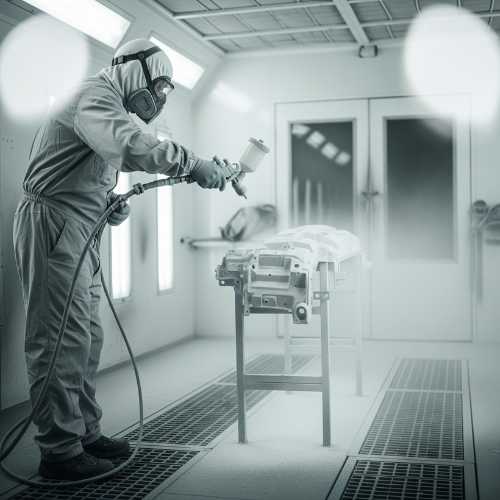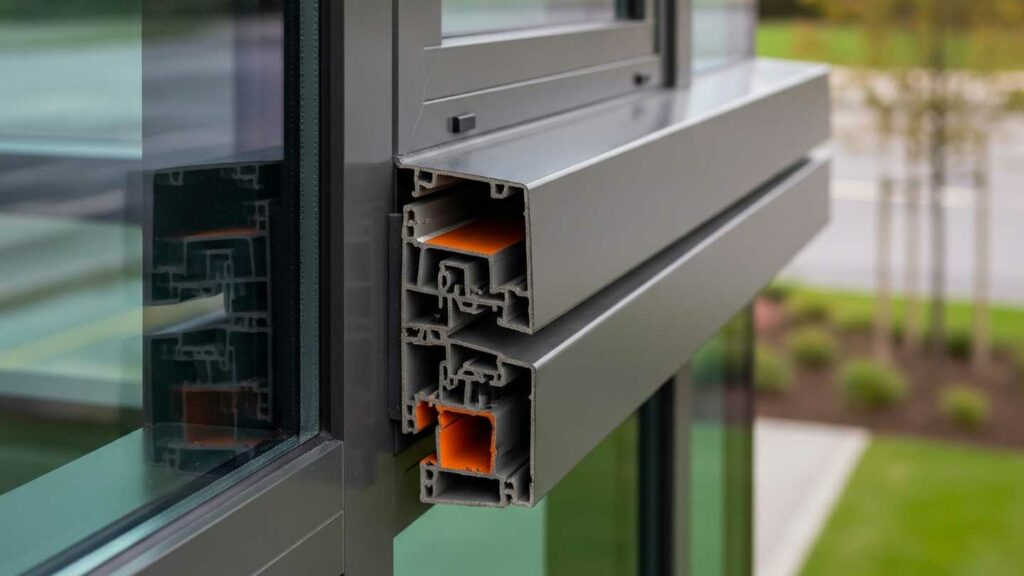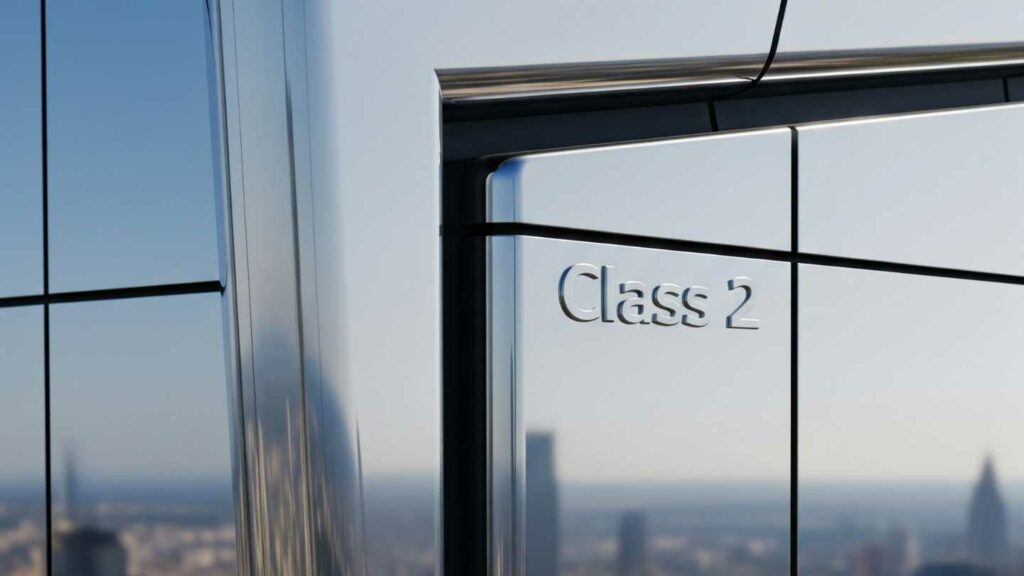Powder coating provides a durable and attractive finish for a wide range of products, including architectural elements and outdoor furniture. If you’re considering powder coating for your next project, you’ve likely encountered terms like “Class 1” and “Class 2.” But what exactly do these classifications mean, and why should you care? Understanding the difference is crucial for choosing the right coating for your needs.
What is Powder Coating?
Before we dive into the classes, let’s briefly recap what Fenster’s approved applicator applies to its mill finish profiles in terms of powder coating. Unlike traditional liquid paint, powder coating is applied as a dry powder through an electrostatic process. The charged powder particles adhere to the grounded surface of the object. The object is then cured in an oven, where the powder melts and flows to form a smooth, continuous, and highly durable film. This application is done by a qualified Qualicoat licensee. Qualicoat Powder Coating used by Fenster offers several advantages, including:
- Durability: Excellent resistance to chipping, scratching, fading, and corrosion.
- Environmental Friendliness: No volatile organic compounds (VOCs) are released during application.
- Aesthetic Appeal: A wide range of colours, textures, and finishes.
- Cost-Effectiveness: Efficient application with minimal waste.

Understanding Qualicoat Powder Coating Classes
Class 1: High-Performance Architectural
Class 1 powder coatings are designed for good outdoor durability and are suitable for many architectural applications where moderate exposure to sunlight and weathering is expected. These coatings offer:
- Good Colour Retention: They maintain their colour well over time, but some fading may occur in harsh conditions.
- Good Gloss Retention: The finish will retain its sheen reasonably well.
- Resistance to Chalking: They are less prone to developing a chalky residue on the surface.
- Salt Spray Resistance: Good protection against corrosion in coastal or high-salinity environments.
When to choose Class 1: If your project involves architectural elements that will be exposed to typical outdoor conditions, such as window frames, door frames, or general building cladding, Class 1 often provides an excellent balance of performance and cost.

Class 2: Superior Architectural
Class 2 powder coatings represent the pinnacle of performance for architectural powder coatings. They are engineered for exceptional long-term durability and are ideal for projects in demanding environments or where maximum colour and gloss retention are critical. These coatings offer:
- Excellent Colour Retention: Significantly better resistance to fading, even in intense sunlight and harsh UV conditions.
- Excellent Gloss Retention: The finish will maintain its original lustre for a much longer period.
- Superior Resistance to Chalking: Virtually no chalking, ensuring the finish remains vibrant and clean.
- Enhanced Humidity and Salt Spray Resistance: Provides the highest level of protection against moisture and corrosive environments.
When to choose Class 2: Opt for Class 2 powder coatings for high-profile architectural projects, buildings in extreme climates (e.g., intense sun, high humidity, coastal areas), or any application where maintaining a pristine appearance and maximum longevity are paramount. Think high-value homes, projects that require longevity, landmark buildings, or structures in highly reflective environments.

What is Qualicoat?
Qualicoat is an international quality label organisation that sets strict standards for powder coating on aluminium for architectural applications. It emerged in 1986 to promote and maintain the quality of aluminium lacquering according to rigorous technical specifications for both the application process and the coating materials themselves. Qualicoat provides a product certification scheme and monitors licensed plants worldwide to ensure compliance.
What does Qualicoat Certification Mean?
A Qualicoat certification provides several key assurances:
- Quality Assurance: It assures customers that their aluminium products have a premium-grade coating.
- Performance Standards: The coatings meet defined quality and performance criteria for durability, colour retention, and resistance to environmental factors.
- Long-term Value: By adhering to these standards, coated aluminium products deliver long-term value and consistent quality.
How to Find a Qualicoat-Certified Company
To find a company with Qualicoat-certified products:
- Look for Certification: Check the company’s website or promotional materials for their Qualicoat certification.
- Ask for Specifications: Inquire if they use Qualicoat-approved powders and if their application processes meet the required standards.
The Florida Test: A Durability Benchmark
Qualicoat’s “Florida test” is not a specific test conducted in Florida, but rather a term used to describe powder coating durability standards that mimic the harsh, subtropical climate of Florida, which includes high sunlight, humidity, and rainfall.
Why the "Florida Test" is Used
- Harsh Environment: Florida’s subtropical environment provides a challenging, real-time weathering test for coatings due to its high levels of sunlight, ultraviolet radiation, high humidity, and significant rainfall.
- Durability Benchmark: Powder coatings are tested against these conditions to assess their durability, corrosion resistance, and colour retention over extended periods. The “Florida” classification indicates superior performance compared to standard tests.
Qualicoat's Florida-Equivalent Classes
Qualicoat uses a tiered system for its durability classes, often referred to in relation to their Florida equivalent:
- Qualicoat Class 1: Requires a minimum of 50% gloss retention after 12 months of exposure and is often known as a “1-year Florida” equivalent.
- Qualicoat Class 2: Requires a minimum of 75% gloss retention after 12 months, 60% after 24 months, and 50% after 36 months, commonly called the “3-year Florida” standard.
Qualicoat Cleaning Instructions
To maintain the longevity and appearance of Qualicoat powder coatings, follow these simple cleaning instructions.
What to Use
- Cleaning Solution: Mix a mild detergent (like dish soap or car wash soap) with warm water.
- Cleaning Tools: Use a soft cloth, sponge, or soft-bristle brush.
- Drying: Use a clean, soft, lint-free cloth, such as a microfiber cloth.
What to Avoid
- Abrasive Materials: Avoid using steel wool, abrasive brushes, or harsh scrub pads.
- Harsh Chemicals: Avoid strong solvents (such as acetone, turpentine, or white spirit), aggressive alkaline or acidic cleaners, bleach, and trisodium phosphate.
- High-Pressure Cleaning: Do not use steam cleaners or high-pressure cleaners with dirt milling.
- Extreme Conditions: Clean in the shade, not in direct sunlight, and avoid cleaning when surfaces are hot.
Step-by-Step Cleaning
- Pre-Rinse: Rinse the surface with cold water to remove loose dirt.
- Apply Soap: Gently apply a light, mild soap solution with a sponge or soft cloth.
- Scrub Gently: Lightly scrub the surface to loosen and remove grime. Do not scour or rub excessively.
- Rinse Thoroughly: Rinse the surface completely with clean, cold water to remove all soap residue, which can cause stains.
- Dry: Dry the surface with a soft, lint-free cloth to prevent water spots.
Frequency & Environment
- Normal Environments: Clean every 6-12 months.
- Harsher Environments: In coastal or industrial areas, clean more frequently, such as every 1-3 months.
Stubborn Stains
For tougher stains, use a non-abrasive cleaner specifically designed for powder coatings or a very diluted vinegar solution. Always test any new cleaner in a small, inconspicuous area first to ensure it doesn’t damage the coating.
Making the Right Choice for Your Fenster Project
Choosing between Class 1 and Class 2 ultimately comes down to balancing performance requirements with budget considerations.
- Consider the environmental exposure: How much sunlight, humidity, and potential for salt exposure will your product be exposed to?
- Consider the desired lifespan: How long do you want the finish to look its best?
- Evaluate the aesthetic importance: Is a perfectly pristine, long-lasting appearance critical for the project’s success?
At Fenster, we’re committed to providing the highest quality powder coating solutions. Our experts can help you assess your project’s specific needs and recommend the ideal Qualicoat powder coating class to ensure your Fenster products not only look fantastic but also stand the test of time.
Ready to discuss your Qualicoat powder coating needs with Fenster? Contact Fenster today for a consultation!

